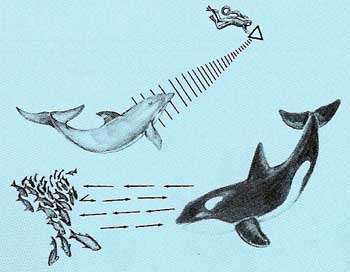
Most of us are familiar with how bats and dolphins use echolocation in order to navigate and identify objects in their environment. Echolocation is when an animal makes a clicking sound and then listens back to the echo; based on that echo an animal can figure out where an object is located (and, in some cases, what that object is).
What surprises me about this unique way of sensing the world is that some humans are capable of doing it too. There are several case studies that show how individuals who were essentially born blind (and have no visual memory) can use echolocation to navigate their environment. Take a look at Daniel here, seen riding a bike through a park using echolocation:
Additionally, a recent study published in the scientific journal PLoS ONE has shown that when blind people use echolocation it activates regions of their brain previously designed for visual processing. This is a very clear demonstration of neuroplasticity, the idea that our experiences can change the structure of our brains.
For example, when we lose a sense such as vision, our brain rewires itself so that unused “brain power” can be applied to a different sense. This is often referred to as “sensory substitution.” In other words, if our brain detects that neural connections aren’t being used, then it will often adjust itself to compensate for that loss by re-utilizing those resources through a different sense.
However, it’s not completely clear that if someone loses vision that they will become more auditory. In some cases, blind individuals gain a heightened sense of touch, which is another way humans can navigate throughout their environment. Imagine yourself getting up late at night to go to the bathroom. It’s dark, so you put your hands in front of yourself to help guide your way (and so you don’t bump into anything). Individuals who are blind experience that permanent sense of darkness, and over time they begin to get better and better at using these other senses to navigate through their surroundings. It may be tactile, it may be auditory – it may be a bit of both. It will probably depend on how the individual chooses to adapt to their surroundings which determines where the unused brain power will be allocated.
What fascinates me about all of this is just how powerful and adaptive our brains can be. And we don’t have to lose a sense to experience neuroplasticity; in fact, neuroplasticity is something that happens throughout our day-to-day experiences. Whenever we learn something new, our brain is making new connections. And with the right attention and practice, there is no doubt that individuals with sight can also develop a skill like echolocation (if they really wanted to). Whenever we apply focus (or “mindfulness”) to what we do, we can actively change the way our brains connect and learn. For more on this, you can check out my article about how mindfulness allows us to self-direct neuroplasticity. Of course, these changes aren’t always as drastic as someone learning how to sense the world in a whole new way, but the fact that these changes can occur can be very encouraging.
Enter your email to stay updated on new articles in self improvement:
